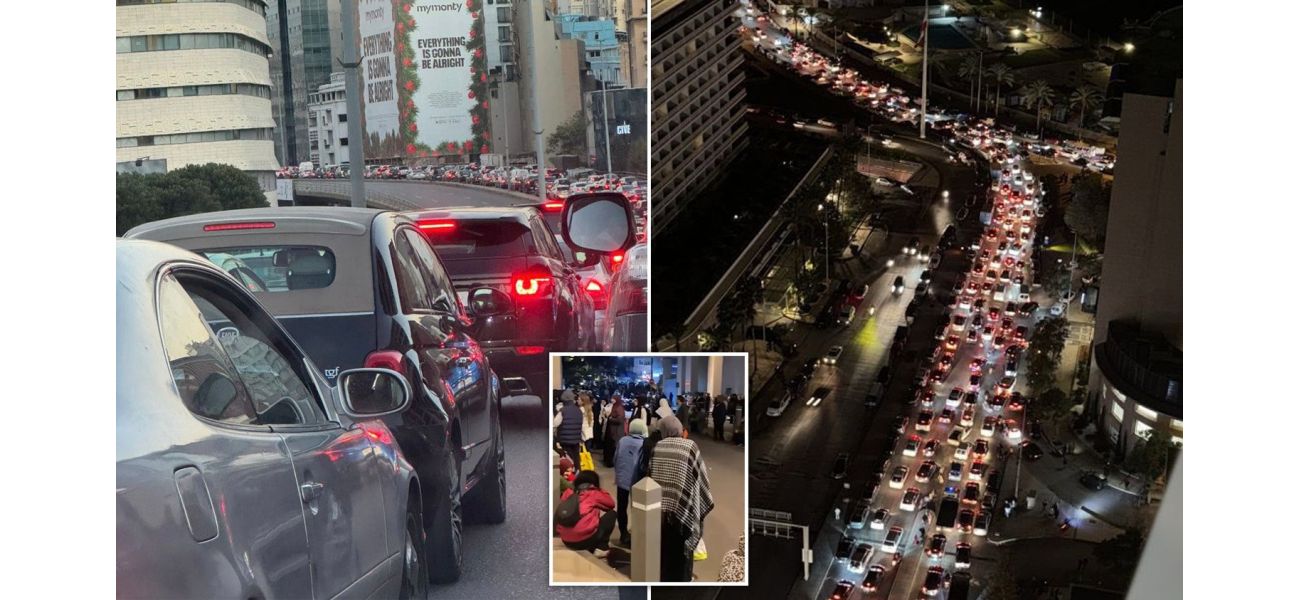Many rushed to flee Beirut before ceasefire, trapped in chaotic and dangerous conditions.
Beirut is experiencing apocalyptic scenes.
November 27th 2024.

As Israel's largest bombing campaign in recent memory began, the people of Beirut scrambled to escape the chaos and destruction. The streets were flooded with cars as the residents tried to flee before the ceasefire with Hezbollah went into effect. In the early hours of the morning, missiles rained down on the city of 2.4 million people, just moments after US President Joe Biden announced the deal that was meant to bring an end to the violence.
The bombing continued until 4am, when the ceasefire finally came into effect. It was a tense and terrifying night for the people of Beirut, with Israeli jets flying over their homes, traffic at a standstill, and the constant sound of ambulance sirens. Throughout the night, Israel's military issued evacuation warnings for over 20 locations in Beirut, including the city center, which had been relatively untouched by the war until now.
The Laylaki and Choueifat al-Amrousieh areas were among the first to receive evacuation orders, with Israel claiming that these locations were in close proximity to Hezbollah facilities. This was followed by a second alert for residents of Borj El Brajneh and Ghobeiry in the southern suburbs. Amidst the chaos, people could be seen abandoning their cars and fleeing on foot, while others sought shelter in buildings or underground shelters.
The American University Hospital opened its doors to students and their families, providing a safe haven for those caught in the midst of the bombing. Meanwhile, Israeli strikes continued to pound the southern suburbs, with at least ten simultaneous attacks - the largest in this area since the war began. One strike even hit near the country's only airport, sending plumes of smoke into the sky.
But what exactly was the ceasefire deal between Israel and Hezbollah? The agreement called for an initial two-month halt in fighting, during which time Hezbollah would be required to withdraw its armed presence from southern Lebanon. In their place, Lebanese army forces would take over, ensuring that any remaining infrastructure or weapons were removed and unable to be rebuilt. Israeli soldiers would also gradually return to their side of the border.
However, the actual implementation of this plan was still uncertain. The agreement was based on UN Security Council resolution 1701, which had ended the 2006 war between Israel and Hezbollah. As the night wore on and the ceasefire took effect, the city of Beirut was left in a state of shock and devastation. Many found their homes destroyed by the overnight strikes, and at least 42 people had been killed by Israeli attacks in the last 24 hours alone.
Amidst the joy and relief of the ceasefire, there was also a heavy weight on the hearts of the people of Beirut. Associate professor Yasmine Khayyat described the apocalyptic scenes she witnessed, with burning buildings, blaring sirens, and a sense of panic everywhere. And while the airstrikes may have stopped, the aftermath of the war was still being felt. The smell of sulfur lingered in the air and the drone of Israeli jets was replaced by the sound of celebratory gunfire.
As everyone tried to make sense of what had just happened and what was to come, professor Mona Fawaz from the American University of Beirut reflected on the heavy toll the war had taken on the city. The ceasefire may have brought a temporary end to the violence, but the people of Beirut were left to pick up the pieces and rebuild their lives. As Lebanon's parliament speaker Nabih Berri stated, this had been the most dangerous phase the country had ever endured.
The bombing continued until 4am, when the ceasefire finally came into effect. It was a tense and terrifying night for the people of Beirut, with Israeli jets flying over their homes, traffic at a standstill, and the constant sound of ambulance sirens. Throughout the night, Israel's military issued evacuation warnings for over 20 locations in Beirut, including the city center, which had been relatively untouched by the war until now.
The Laylaki and Choueifat al-Amrousieh areas were among the first to receive evacuation orders, with Israel claiming that these locations were in close proximity to Hezbollah facilities. This was followed by a second alert for residents of Borj El Brajneh and Ghobeiry in the southern suburbs. Amidst the chaos, people could be seen abandoning their cars and fleeing on foot, while others sought shelter in buildings or underground shelters.
The American University Hospital opened its doors to students and their families, providing a safe haven for those caught in the midst of the bombing. Meanwhile, Israeli strikes continued to pound the southern suburbs, with at least ten simultaneous attacks - the largest in this area since the war began. One strike even hit near the country's only airport, sending plumes of smoke into the sky.
But what exactly was the ceasefire deal between Israel and Hezbollah? The agreement called for an initial two-month halt in fighting, during which time Hezbollah would be required to withdraw its armed presence from southern Lebanon. In their place, Lebanese army forces would take over, ensuring that any remaining infrastructure or weapons were removed and unable to be rebuilt. Israeli soldiers would also gradually return to their side of the border.
However, the actual implementation of this plan was still uncertain. The agreement was based on UN Security Council resolution 1701, which had ended the 2006 war between Israel and Hezbollah. As the night wore on and the ceasefire took effect, the city of Beirut was left in a state of shock and devastation. Many found their homes destroyed by the overnight strikes, and at least 42 people had been killed by Israeli attacks in the last 24 hours alone.
Amidst the joy and relief of the ceasefire, there was also a heavy weight on the hearts of the people of Beirut. Associate professor Yasmine Khayyat described the apocalyptic scenes she witnessed, with burning buildings, blaring sirens, and a sense of panic everywhere. And while the airstrikes may have stopped, the aftermath of the war was still being felt. The smell of sulfur lingered in the air and the drone of Israeli jets was replaced by the sound of celebratory gunfire.
As everyone tried to make sense of what had just happened and what was to come, professor Mona Fawaz from the American University of Beirut reflected on the heavy toll the war had taken on the city. The ceasefire may have brought a temporary end to the violence, but the people of Beirut were left to pick up the pieces and rebuild their lives. As Lebanon's parliament speaker Nabih Berri stated, this had been the most dangerous phase the country had ever endured.
[This article has been trending online recently and has been generated with AI. Your feed is customized.]
[Generative AI is experimental.]
0
0
Submit Comment





